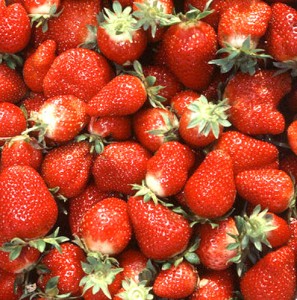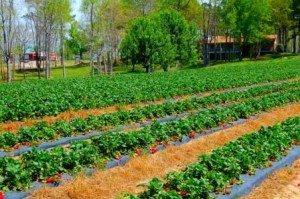 The famous garden strawberry is a common plant of the genus Fragaria cultivated worldwide for its aggregate accessory fruit, the (common) strawberry. The fruit is widely appreciated, mainly for its characteristic aroma but also for its bright red color, and it is consumed in large quantities, either fresh or in prepared foods such as preserves, fruit juice, pies, ice creams, and milk shakes.
The famous garden strawberry is a common plant of the genus Fragaria cultivated worldwide for its aggregate accessory fruit, the (common) strawberry. The fruit is widely appreciated, mainly for its characteristic aroma but also for its bright red color, and it is consumed in large quantities, either fresh or in prepared foods such as preserves, fruit juice, pies, ice creams, and milk shakes.
In the Philippines, strawberries are popularly grown in cool areas like Benguet and Baguio. One of the popular is the Strawberry Farm in La Trinidad Valley, Benguet where one activity that is highly recommended is strawberry picking.
Growing strawberry plants is very easy. You can grow strawberries plants in a variety of ways. They are ideal for growing in pots, hanging planters, special strawberry pots or in a garden strawberry bed. They can be quite expensive in stores and at road-side stands. Growing your own delicious strawberries that come back year after year is rewarding as well as economical. They are relatively easy to grow, and they do not take up a lot of valuable space in the garden.
Varieties:
First of all, you should decide which type of strawberry plant you want to grow. They basically come in three varieties:
- June Bearing: this strawberry plant is the most common, producing one large crop per year, during a 2-3 week period in spring. June bearers produce lots of runners and flowers, and are subdivided into early, mid-season and late varieties. The fruits they produce are usually the largest of the three types
- Everbearing: these plants do not send out many runners, but they produce two or three intermittent crops during the fall, spring and summer. Their berries are generally smaller than June bearing
- Day Neutral: these plants are similar to the everbearing variety, in that they produce small berries, albeit throughout the growing season (and not intermittently).
You should choose June bearing plants if you have ample space for them, while everbearing and day neutral types are best for growing strawberries indoors.
How to grow Strawberry:
Site Selection
You should bear in mind that strawberries need a lot of sun, so they should be exposed to sunlight for at least six hours per day. They prefer a slightly acidic soil, with a pH from 5.8 to 6.3. A well drained, sandy loam is the ideal setting. You should avoid planting in heavy clay soils. If your soil is sandy, give proper attention to watering and fertilization. Nonetheless, with careful planning, strawberries will, in fact, tolerate a very wide range of soil types, providing you do properly modify the soil. You are able to improve most garden soils by adding organic matter : the best soil amendment is often compost, which will give sustenance to the plants, protect them from disease and improve the soil. Some gardeners add bone meal to the soil.
Please be aware that certain plants such as eggplants, tomatoes, peppers and potatoes carry a dangerous Verticillium that can cause your strawberry plant to rot, so you should plant it far from the aforementioned vegetables.
Success depends on many factors, but the most important are making sure that your plant is disease free (it should be certified as such) and choosing a plant with light-colored, healthy roots and large crowns. It should be planted in a hole large enough to spread the roots, with a hilled center, and the crown placed at soil level: the roots should be spread down the central hill, and the plant should be buried only halfway up the crown. Using organic matter (about 1 to 2 inches) ensures enough nutrients and is highly recommended.
System of Planting
1. Matted Row System
Strawberries in a matted row system is recommended for June bearing varieties. As a general rule, the matted row system is good for plants sending out lots of runners (e.g. June bearing strawberries). Plants should be set 18 inches apart in rows of 24 inches, with 4 – 4 1/2 feet between rows. Shortly after planting, you should start to see flower buds and leaves: flowers should be pinched off for the first year (in June bearing varieties); this will allow for a healthier plant and more runners, and will ensure a larger crop, for more years, in the following cycles. Everbearing and day neutral varieties’ flowers should be pinched off only until July 1st.
When you start seeing runners from the crown, train them along the row and space them 6 to 9 inches apart, pressing them gently into the soil and keeping them there with a light weight or an inch of soil until their roots have grown; severing runners from the mother plant is not recommended.
2. Hill System
The hill system is recommended for varieties that produce few runners, namely everbearing and day neutral. This system consists of a raised bed 2 feet wide and 7 inches high, with plants in staggered double rows, 13 inches apart. If you want a higher crop production and a healthier plant, you should sacrifice runners and flowers until the beginning of July in the first year; you can then let them produce at will.
Please be aware that these plants should be replaced every 3 to 4 years, since multiple harvests tend to significantly slow down their production after this period.

Mulching
Mulching is recommended to keep the soil cool and moist, and to prevent weeds from stealing valuable nutrients from your plant. A good option is the traditional straw, and you should avoid any material that causes the soil to heat (such as dark plastic) since this will hamper fruit production.
If you live in a cold climate, it is advisable to mulch over the strawberry plant to prevent the crowns from frosting, starting when the temperature drops to 18-19 F degrees. Again, straw is recommended, as are pine needles and any kind of mulch that can be easily removed in spring.
Watering and Fertilizing
Your strawberry plant should be watered with about 1-2 inches of water, per week. You should take care especially from the early bloom to the end of harvest, since this is the time when fruit is forming and its water needs are higher.
If you began with organic soil as suggested, you have the beginning part covered: you should follow it up with a 10-10-10 balanced fertilizer (about 1 lb. per 100 square feet) when planting, and again after the second harvest of everbearing and day neutrals (or after renovation of June bearers).
More is not necessarily better with fertilizers: too much will improve leaf growth at the expense of flowers (and fruit); fertilizing in the cold season is also not recommended since new growth will probably frost and reduce the plant’s yield.
Pests And Diseases
Strawberry Cascade – container-grown strawberries generally suffer from fewer diseases than those in the ground, but can attract pests, especially under glass. Aphids may infest spring growth, transmitting viruses that debilitate plants. Spray at the first sign of damage with a proprietary insecticide suitable for strawberries such as one containing bifenthrin or malathion. I suggest an organic insecticide.
Two spotted spider mite (Tetranychus urticae) – can be a problem, particularly in warmer situations, and is best controlled with the predatory mite Phytoseiulus persimilis, provided no pesticides are being used.
Vine weevil larvae (Otiorhynchus sulcatus) – are unlikely to be a problem in the first year, but plants grown on for a second year may be affected. Treat in August by watering in a proprietary brand of nematodes, which parasitize the larvae.
Harvesting
Fruit harvested in the morning will usually have a longer shelf-life. Pick the berries when the top of the strawberry is completely red-once picked they will not continue to ripen. Make sure you pick all ripe berries; fruit left on the plant become overripe, which helps promote development of disease and causes insect problems. You can refrigerate strawberries for several days. You should avoid washing fruit until just before you use it, this is necessary to order to avoid softening and decay.
Tips for bringing home fresh strawberries:
- Do not buy those already pre-packed in baskets or Styrofoam containers as they may be cheaper because you’re really buying a half kilo of tiny strawberries with only a layer of large ones on top.
- Choose the “under-ripe” ones: those that are less red and more green and white. By the time you get home, the strawberries will be just right.
- Do not put heavy objects on top of your basket or box of fresh strawberries.
Sources: Wikipedia.com, www.cdcg.org, strawberriesweb.com; Photos: Wikipedia.com, gurosiksberryplantation.com